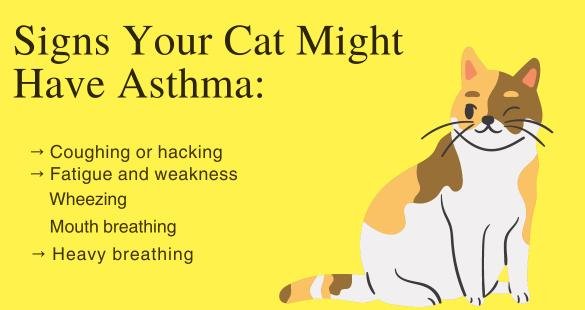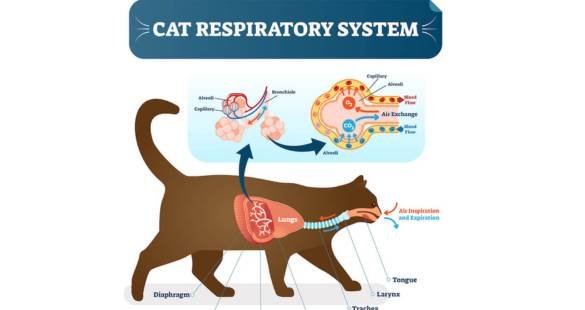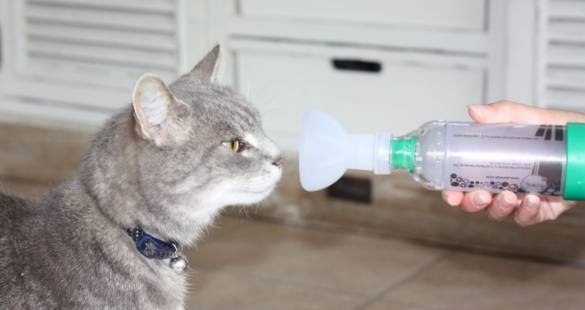Feline asthma is a common breathing problem in cats. It occurs when their airways become inflamed, making it difficult for them to breathe. Understanding feline asthma can help you take better care of your cat and keep them healthy.
To treat feline asthma, veterinarians typically prescribe corticosteroids to decrease lung inflammation, often in combination with bronchodilators to widen the airways. These medications are available in oral, inhaled, and injectable forms
What Is Feline Asthma?
Feline asthma is a condition that affects how your cat breathes. Like asthma in humans, it can cause symptoms such as wheezing, coughing, and difficulty getting air. Some cats, especially those with allergies, are more likely to develop asthma.
Signs Your Cat Might Have Asthma
Identifying the signs of asthma in cats is crucial for timely intervention. Here are some key symptoms to look out for:
Wheezing
You may hear a wheezing sound when your cat breathes. This high-pitched noise typically indicates that the cat’s airways are constricted and struggling to get enough air.
Rapid or Labored Breathing
If you notice your cat breathing rapidly or with noticeable effort, it may indicate respiratory distress. Look for signs such as flared nostrils or visible abdominal movements while breathing.
Persistent Coughing
A consistent cough, especially one that resembles gagging or coughing up a hairball, can indicate asthma. This type of cough may not always produce mucus but can be alarming.
Coughing Up Frothy Mucus
During an asthma episode, your cat may cough up frothy mucus. This symptom can indicate irritation in the airways and requires attention.
Breathing Difficulty After Exercise
If your cat has trouble catching their breath after physical activity, it may indicate an underlying respiratory issue. Difficulty breathing post-exertion is a common sign of asthma.
Open-Mouth Breathing
Cats usually breathe through their noses. If you see your cat with its mouth open while breathing, it may suggest that it is struggling to get enough air.
Extended Neck and Gasping
In severe cases, your cat may extend its neck upwards and gasp for breath. This posture helps it attempt to open its airways wider to breathe more easily.
During an Asthma Attack
When a cat experiences an asthma attack, it can be frightening for the cat and its owner. Recognizing the symptoms early leads to prompt action and potentially life-saving care. Here are key signs to watch for:
Squatting with Neck Extended
One of the first signs you may notice is your cat adopting a squatting position with its neck extended. This instinctive posture helps cats open their airways, allowing for easier breathing. While in this position, your cat may appear tense and uncomfortable as it struggles to get enough air.
Blue Lips or Gums
A critical warning sign during an asthma attack is the appearance of blue lips or gums, known as cyanosis. What indicates a lack of oxygen in the blood is a severe medical emergency. If you see this symptom, seeking immediate veterinary attention is crucial, as your cat may be in danger.
Wheezing
Wheezing is a common symptom during an asthma attack. You might hear a high-pitched whistling sound as your cat breathes, indicating that their airways are constricted. This sound is alarming and signals that your cat needs urgent care.
Coughing
Frequent coughing is also prevalent during an asthma attack. Your cat may cough or hack as it attempts to clear its airways. This coughing can come in bursts, ranging from dry to producing mucus. Pay close attention to how often your cat coughs and whether it seems to cause discomfort.
Other Symptoms to Monitor
In addition to the primary signs of an asthma attack, several other indicators may suggest your cat is experiencing distress. You might notice that your cat’s symptoms are worsening, including increased coughing, breathlessness, and wheezing. This is another concerning sign that their usual reliever inhaler (if prescribed) isn’t providing relief.
Changes in Activity Levels
You may observe your cat becoming too breathless to engage in everyday activities like playing, eating, or sleeping. Their breathing may become rapid and shallow, and it might seem like they cannot catch their breath. In some cases, particularly with younger cats, they may also exhibit signs of discomfort in their tummy or chest.
Gradual onset of Symptoms
It’s important to note that the symptoms of an asthma attack may not always come on suddenly; they can develop gradually over several hours or even days. This slow onset can make it challenging to recognize the severity of the situation, making it essential to keep a close eye on your cat’s behaviour and breathing patterns.
Taking Action
Knowing these signs, you can act quickly to help your cat during an asthma attack. If you notice any combination of these symptoms, especially blue lips or gums, it’s vital to seek veterinary assistance immediately. Staying calm and prepared can significantly affect your cat’s health and recovery.
What Causes Cat Asthma?
Various environmental and genetic factors influence feline asthma. Understanding these causes can help you manage your cat’s health and minimize the risk of asthma attacks. Here are some primary triggers:
Cat Litter Dust
Many types of cat litter produce dust when cats dig or scratch. This dust can irritate your cat’s airways, leading to respiratory issues. Clumping litters, particularly clay ones, are notorious for generating dust. Choosing low-dust or natural alternatives can help reduce exposure to these irritants.
Tobacco Smoke
Cigarette smoke is a significant environmental pollutant that can worsen asthma symptoms in cats. Even if you don’t smoke directly around your cat, secondhand smoke can linger on clothing, furniture, and in the air, creating a harmful environment. Reducing or eliminating tobacco smoke exposure is crucial for your cat’s respiratory health.
Dust Mites
Dust mites are microscopic organisms that thrive in household dust. They are common allergens for both humans and pets. Cats exposed to dust mites can develop respiratory issues, including asthma. Regular cleaning, vacuuming with a HEPA filter, and using air purifiers can help reduce dust mite populations in your home.
Household Cleaning Products
Many household cleaning products contain strong chemicals and fragrances that can irritate your cat’s respiratory system. Products like bleach, ammonia, and air fresheners can release fumes that trigger asthma symptoms. Opting for pet-safe, non-toxic cleaning solutions can help create a healthier environment for your cat.
Mould
Mold thrives in damp, humid conditions and can release spores that are harmful to cats. Growing mould can contribute to asthma and other respiratory issues if your home grows mould. Regularly inspect areas prone to moisture, such as bathrooms and basements, and address any water leaks promptly to prevent mould growth.
Pollen
Seasonal allergens like pollen from trees, grasses, and weeds can significantly affect cats with asthma. During certain times of the year, exposure to high pollen counts can trigger coughing, wheezing, and other asthma symptoms. Keeping your cat indoors during peak pollen seasons and using air purifiers can help reduce exposure.
Grass
Like pollen, grass can irritate some cats, mainly if they are allergic to specific types of grass. Notice that your cat exhibits respiratory symptoms outdoors or after lawn mowing. It may be beneficial to limit their exposure to grassy areas.
Some Foods
Certain food ingredients can trigger allergic reactions in cats, potentially leading to asthma symptoms. Common culprits include grains, dairy, and specific proteins. If you suspect that food may be a trigger for your cat, consult your veterinarian to discuss an elimination diet or hypoallergenic food options.
Aerosol Spray Dispensers
Aerosol sprays, such as air fresheners, insecticides, and some grooming products, can release fine particles and chemicals into the air that may irritate your cat’s respiratory system. If you use these products, ensure your cat is in a different room until the area is well-ventilated.
Diagnosing Feline Asthma
- Diagnosing feline asthma involves several steps. First, your veterinarian will gather a detailed medical history, asking about your cat’s symptoms, frequency, and potential triggers.
- Next, a physical examination is conducted. The vet will listen to your cat’s lungs for abnormal sounds like wheezing and assess their breathing rate and effort.
- Diagnostic tests may include chest X-rays to identify lung changes and rule out other conditions. A bronchoscopy might examine the airways and collect mucus samples directly.
- If allergies are suspected, allergy testing can help identify specific triggers. It’s also crucial to rule out other respiratory issues like heart disease or infections.
- Sometimes, monitoring your cat over time may be necessary to see how they respond to treatment. Early diagnosis is essential for effectively managing feline asthma and can significantly improve your cat’s quality of life.
Living with a Cat with Asthma
Here are some tips for daily care:
- Avoiding cats is one of the most effective ways to manage cat-related asthma. However, treatments and cleaning practices can help alleviate symptoms if you have a cat at home.
- Asthma and allergy medications, immunotherapy, and air filters can significantly reduce environmental irritants. Additionally, keeping the cat out of the bedroom can create a more comfortable space and minimize exposure to allergens.
When to See a Vet
Emergency Signs
- Know when to take your cat to the vet. If your cat has blue lips or is breathing poorly, get them to the vet immediately.
Routine Check-Ups
- Regular visits are essential to manage asthma effectively.
Why Inhaled Medication is Better
Inhaled medication is often better for managing feline asthma because it delivers medicine directly to the lungs, providing faster relief of symptoms.
This method requires less medication overall, reducing potential side effects. Inhalers are effective at targeting airway inflammation, and many cats tolerate them better than pills, which can be stressful to administer. With proper training, most cats can quickly adapt to using an inhaler, making it a convenient and efficient treatment option.
Related Topics.(https://trendingdots.com/cats-sleeping-positions/)
How to Use a Cat Inhaler
If your vet gives you an inhaler, here’s how to use it:
- Put the Mask on Your Cat: Place it over their nose and mouth.
- Give the Medication: Follow your vet’s instructions for how much to give.
- Stay Calm: Treat your cat afterwards by making the experience positive.
Conclusion
Feline asthma can be managed with the proper care and attention. Learning about the condition, recognizing the signs, and working with your vet can help your cat lead a healthy and happy life. Regular check-ups and proactive management are vital to keeping your furry friend comfortable.







